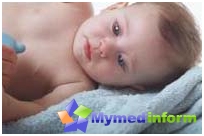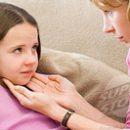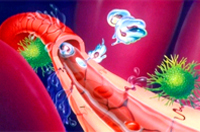The intestinal colic is one of the most common complaints of parents of breast-age parents when contacting the pediatrician. Intestinal colic can be worn as a functional nature and develop in healthy children and be a manifestation of the disease of the digestive tract.
Content
Concept of intestinal colic in children
 Intestinal colic, perhaps, one of the most frequent complaints of parents' parents. It is registered in 10-15%, and according to some data, 30-70% of infants, mainly in children, starting with 3 weeks of life.
Intestinal colic, perhaps, one of the most frequent complaints of parents' parents. It is registered in 10-15%, and according to some data, 30-70% of infants, mainly in children, starting with 3 weeks of life.
Under the intestinal colic, the episodes of grapple-shaped sharp pain in the stomach, which are accompanied by a piercing cry and the sustain of the legs attracted with legs with legs. Moreover, intestinal colic can be observed both in practically healthy children (the so-called functional intestinal colic) and in children with diseases, mainly the gastrointestinal tract (there is an intestinal colic - a symptom of the main disease).
Term «colic» Comes from Greek «Colicos», What means «Pain in the colon». Pain occurs in the intestine of the child due to increased gas formation and stretching the intestinal walls by the resulting gas bubbles.
Typically, the functional intestinal colic does not cause severe child health disorder, but nevertheless it has an impact on his mental development and significantly violates the psychological climate in the family, creating parental tensions due to their abdominal pain and kid's concern. In the same cases, when the intestinal colic is constant, repeats from day to day, and long-term, a few hours a day, it can be complicated by secondary disorders of the intestinal microbiocenosis and enzymatic disorders.
Intestinal colic risk factors in children
There are two groups of factors causing intestinal colic in infants. The first is characteristic of practically healthy children, who even a sighting additional examination does not reveal any pathology. It is usually developing on 3-4 weeks of the child's life, unexpectedly, in the afternoon, usually after 15 hours and first briefly (lasts for 15-20 minutes). As a rule, it develops from firstborn, more often in boys. These children are usually born in mothers with an elevated level of anxiety.
The first group of factors include feeding the kid incorrectly cooked mixtures (excessive breeding or, on the contrary, small breeding of mixtures). Too fast sucking, air swallowing with sucking (Aerofagi), may also cause colic development. One of the possible causes of colic can be a bowel reaction to the baby's food used by the mother and having increased gas formations that penetrate into breast milk. In addition, it is assumed that the intestinal colic in practically healthy children can be due to the lack of developing or features of metabolism in the progesterone motherhood, which is also reflected in the composition of breast milk.
The second group of factors causing intestinal colic are child diseases, and above all the diseases of the gastrointestinal tract. In this case, the intestinal colic acts as the main symptom of the main disease. Most often it happens the food intolerance, arising on the basis of lactase insufficiency, allergies to proteins of cow milk or other components of nutrition and enterocolitis caused by conditionally pathogenic microorganisms (normally present in the gastrointestinal tract and cause the disease only with a decrease in the activity of the immune system) and Intestinal infection.









